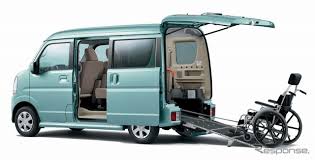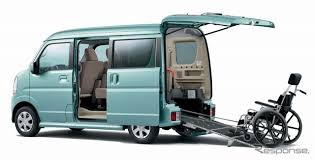
Japanese technology and vehicle companies innovating to create both high- and low-tech products for consumers to allow ease of use for the fast aging Japan’s population.
This became evident at a Japan’s exhibition for nursing care and rehabilitation, the largest in Asia, where Japanese giants like Toyota, Nissan, Hitachi and Fujitsu were among some 500 participants attending the exhibition.
The 42nd Home Care and Rehabilitation Exhibition in organized in Tokyo saw the companies plating up a wide range of high- and low- tech products for the found for the country’s fast-ageing population and the disabled.
Motorcycle company Yamaha Motors, for example, showcased both self-powered and motor-assisted wheel chair concept that they were in the process of developing.
“Independence is our key word. Do it for yourself. We aim to support that with our electric wheelchair,” said Masanori Yonemitsu, general manager of JW Wheelchairs Division at Yamaha Motor.
Like Yamaha, there were many other companies that are looking to assistive technologies help and assist the elderly.
“We are looking at mobility products using robotic technology to assist the elderly to get out of the wheelchair for instance. Once they get into a standing position, this mobile device will take them around and will strengthen their muscles so they’re able to be more independent,” said Takaaki Yoshikawa, councilor of advanced R&D planning and promotion at Panasonic.
The new technology would allow the staff on duty at care homes to be immediately informed if a resident is out of bed as the new technology is able to detect whether or not a dementia sufferer is in bed. With the further development of the technology the company behind this system aims to expand its business seven-fold in 10 years from now.
The organizers of the Home Care and Rehabilitation Exhibition said that the exhibition space they are taking up is expanding - particularly with the major manufacturers even though the number of companies participating had not necessarily significantly increased over the years.
According to the Japan Assistive Products Association the welfare-related industry was worth US$11 billion in 2013 which had doubled compared to 2012.
The exhibition housed a range of products that ranged from staircase rails to baths that can measure the weight of elderly users.
Despite being designed for different demographics and purposes some of the products are gaining popularity in this market. However experts have advised the market to exercise greater caution even as the market fast develops.
“The evaluation of these devices in terms of benefits of daily lives should be clearly defined,” said Dr Yoshio Matsumoto, team leader of the Service Robots Research Team at the National Institute of Advanced Industrial Science and Technology.
Assistive technology market is poised to grow steadily in Japan given that 30 per cent of the country’s population would be aged 65 years or above by 2025. Japanese governments have estimated that without proper care, one in five among the aging population would suffer from dementia which would put Japanese Prime Minister Shinzo Abe’s new tagline, "Activating the 100 million population", far out of reach.
(Source:www.channelnewsasia.com)
This became evident at a Japan’s exhibition for nursing care and rehabilitation, the largest in Asia, where Japanese giants like Toyota, Nissan, Hitachi and Fujitsu were among some 500 participants attending the exhibition.
The 42nd Home Care and Rehabilitation Exhibition in organized in Tokyo saw the companies plating up a wide range of high- and low- tech products for the found for the country’s fast-ageing population and the disabled.
Motorcycle company Yamaha Motors, for example, showcased both self-powered and motor-assisted wheel chair concept that they were in the process of developing.
“Independence is our key word. Do it for yourself. We aim to support that with our electric wheelchair,” said Masanori Yonemitsu, general manager of JW Wheelchairs Division at Yamaha Motor.
Like Yamaha, there were many other companies that are looking to assistive technologies help and assist the elderly.
“We are looking at mobility products using robotic technology to assist the elderly to get out of the wheelchair for instance. Once they get into a standing position, this mobile device will take them around and will strengthen their muscles so they’re able to be more independent,” said Takaaki Yoshikawa, councilor of advanced R&D planning and promotion at Panasonic.
The new technology would allow the staff on duty at care homes to be immediately informed if a resident is out of bed as the new technology is able to detect whether or not a dementia sufferer is in bed. With the further development of the technology the company behind this system aims to expand its business seven-fold in 10 years from now.
The organizers of the Home Care and Rehabilitation Exhibition said that the exhibition space they are taking up is expanding - particularly with the major manufacturers even though the number of companies participating had not necessarily significantly increased over the years.
According to the Japan Assistive Products Association the welfare-related industry was worth US$11 billion in 2013 which had doubled compared to 2012.
The exhibition housed a range of products that ranged from staircase rails to baths that can measure the weight of elderly users.
Despite being designed for different demographics and purposes some of the products are gaining popularity in this market. However experts have advised the market to exercise greater caution even as the market fast develops.
“The evaluation of these devices in terms of benefits of daily lives should be clearly defined,” said Dr Yoshio Matsumoto, team leader of the Service Robots Research Team at the National Institute of Advanced Industrial Science and Technology.
Assistive technology market is poised to grow steadily in Japan given that 30 per cent of the country’s population would be aged 65 years or above by 2025. Japanese governments have estimated that without proper care, one in five among the aging population would suffer from dementia which would put Japanese Prime Minister Shinzo Abe’s new tagline, "Activating the 100 million population", far out of reach.
(Source:www.channelnewsasia.com)





